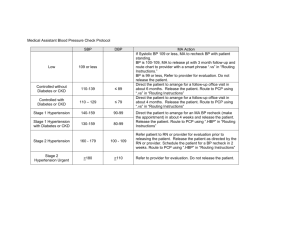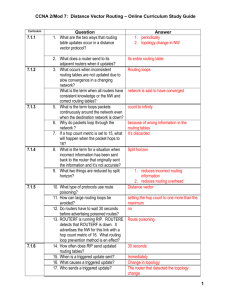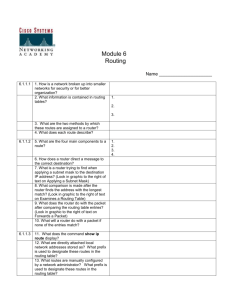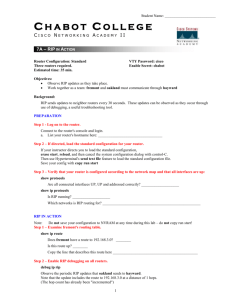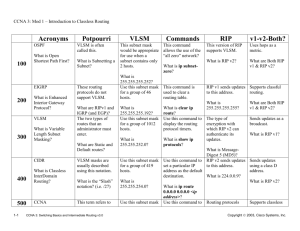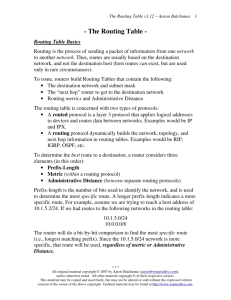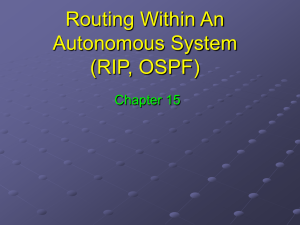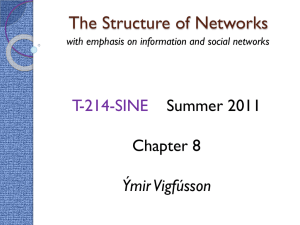6: Routing
advertisement
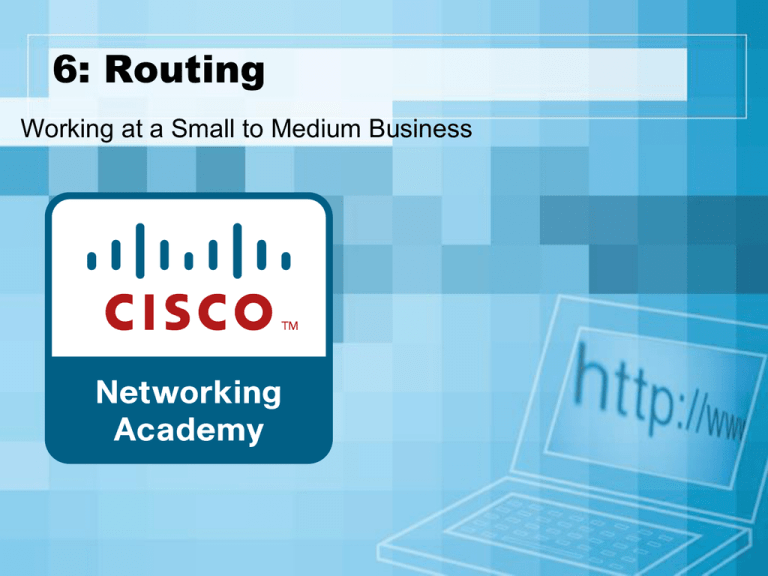
6: Routing Working at a Small to Medium Business Basics • Routers can be used to break network smaller – Subnet • To go from router to router – Routing table – Finds route to other networks – Statically set – Dynamically learned The Routing Table • Router looks at destination IP & SM – ANDing the destination IP & SM • Result is a network # • Looks in table for the match & forwards it out that interface • No match= default route, if set • Routing Table has list of networks & paths The Routing Table Configuring the Static Route • ip route destination_network subnet_mask next hop ip or outgoing int • R1(config) #ip route 192.168.16.0 255.255.255.0 192.168.15.1 PT 6.1.1.5 What would be the static route on R2 to reach the ladies’ network? Dynamic Routing Protocols • Maintain tables when changes occur – Bad cables, interfaces go down, better route learned – Best route to a network in table – Removes routes when no longer valid • When all routers agree on topology= converged • Two routers can exchange these tables as long as they use the same protocol Distance Vector Routing • Passes updates every so often to connected neighbors • Distance & Direction – Metric (hops, speed, reliability, etc) Distance Vector Routing & Lab • Interface that leads to the connected network has a distance (metric) of 0 • Neighbors update each other & add on how far away it is Star is 2 away Star is 0 away Star is 1 away Star is 2 away Practice • 6.1.2.4 • 6.1.2.5 Lab RIP- Routing Information Protocol • DV • Metric is Hops – Only15 Max; 16 is unreachable (D) • Updates every 30 seconds by default – Sends entire routing table (D) – If change, update sent immediately (triggered) – Slow to converge whole network (D) • Administrative Distance is 120 RIP • RIPv1 – Doesn’t send subnet mask in updates – Classfull subnetting • RIPv2 – Classless subnetting RIP EIGRP • Enhanced Interior Gateway Routing Protocol – Cisco proprietary DV (mix LS & DV) – AD of 90 – Many metrics (bandwidth, delay, load, reliability) – Up to 224 hops – Routing Table, Neighbor Table, Topology Table – Updates on start of router & only when a change happens – VLSM Support EIGRP Tables • Neighbor Table – Has info about neighbor direct connect routers • Topology Table – Built from advertisements of its neighbors – Contains ALL routes advertised by neighbor routers – DUAL calculates the shortest path to a destination and installs it into the routing table – Is able to find the best alternate path quickly when a network change occurs – If no alternate route exists it asks its neighbors to find a new path to the destination Link State Routing • Knows routes further away • LSA • Topological database – Info from LSAs • SPF – Each change causes new calc & database update – Map of network from point of view of the router – Info in tree is used to build the routing table OSPF • • • • AD of 110 Metric is cost Uses SPF Sends updates only when the topology changes – Does not send periodic updates of the entire routing table • Fast convergence • Supports VLSM • Provides route authentication Which to Use?????? DV vs. Link State Summary of Routing Protocols Protocol RIP v1 DV or LS DV RIP v2 DV EIGRP DVHybrid OSPF LS AD Metric Features Hops 15 hops max 120 Hops 15 max; VLSM 90 Bandwidth, Load, Delay, Reliability Cisco’s; VLSM Cost Multivendor; VLSM 120 110 Routing • May be multiple routes to same path – Use AD (metrics) to pick best path – Lowest AD is best Configure RIP • Router(config)#router rip • Router (config-router)#version 2 • Router(config-router)#network network-number Verifying RIP • Ping • Show ip route • Show ip protocols •PT 6.1.5.3 •Lab 6.1.5.4 Show ip protocols output Show ip route output Administrative Distance/metric; lower AD to a network=more trustworthy route Problems with RIP Autonomous Systems • A network under one administration – An ISP & its customers • Large businesses have their own AS – Each has unique AS# – Manages all routes to it Activity Routing Between AS • IGP runs within your network & between your routers – RIP, EIGRP, OSPF • EGP runs between different AS – Most common is BGP – Runs on border gateway routers • The router at the end of an AS – Finds the best path between AS AS- Link Routing Across Internet Help from the ISP • Keep the Internet connection available • ISP provides backup routes & routers • ISP advertises routes to other AS – If route fails, sends an update with a backup route ISP Handling of Traffic- Link • Local traffic – Stays within the AS • Transit traffic – Outside of AS to go in/through AS – Like detouring traffic from Rt.55 onto Tanyard Rd. • Could cause overflow of traffic • Can’t handle that much • AS may or may not allow this traffic Configure the Border Gateway • Static Route to ISP • If router participates in the AS, configure BGP Lab 6.2.5 on PT Review 6: Routing Working at a Small to Medium Business

